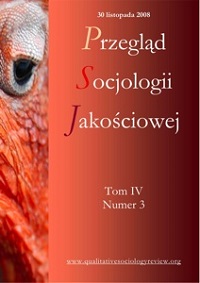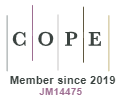Wizualna teoria ugruntowana. Rodziny kodowania wykorzystywane w analizie wizualnej
DOI:
https://doi.org/10.18778/1733-8069.4.3.05Słowa kluczowe:
metodologia teorii ugruntowanej, wizualna teoria ugruntowana, socjologia wizualna, analiza danych wizualnych, kodowanie danych, kodowanie otwarte, kodowanie selektywne, kodowanie zogniskowane, kodowanie teoretyczne, badania jakościowe, socjologia jakościowa, symboliczny interakcjonizmAbstrakt
W niniejszym artykule podejmowane będą próby objaśnienia kodowania obrazów poprzez wykorzystanie zapożyczonych z teorii ugruntowanej, znanych i niejako skonstruowanych przez badaczy rodzin kodowania, które nadają się do analizy tego typu danych. Celem artykułu jest wykorzystanie najistotniejszych elementów składających się na teorię rodzin kodowania zaproponowaną przez B. Glasera (1978), jak również próba wykorzystania paradygmatu kodowania J. Corbin i A. Strauss’a. Tezą artykułu jest: dane wizualne mogą być traktowane jako prawomocne i wartościowe materiały empiryczne, na podstawie których można budować pewne teorie i propozycje teoretyczne. Dane wizualne rozpatrywane mogą być w zestawieniu z innymi danymi, jako pewien uzupełniający typ danych bądź też mogą być wykorzystane jako dane podstawowe.
Pobrania
Bibliografia
Ball Mike and Greg Smith (2007) “Technologies of Realism? Ethnographic Uses of Photography and Film”, W: Paul Atkinson, Amanda Coffey, Sara Delamont, John Lofland, Lyn Lofland (Red.) Handbook of Ethnography, LA, Londyn, New Delhi, Singapore: Sage.
Google Scholar
Berger, John (1972) Ways of Seeing, Londyn: Penquin Books.
Google Scholar
Blumer, Herbert (1969) Symbolic Interactionism. Perspective and Method. Berkeley, Los Angeles, London: University of California Press.
Google Scholar
Bowen, Glenn A. (2008) “Naturalistic inquiry and the saturation concept: a research note”. Qualitative Research, Vol. 8, No 1: 137-152.
Google Scholar
DOI: https://doi.org/10.1177/1468794107085301
Bryant, Antony (2003, January) “A Constructive/ist Response to Glaser [25 paragraphs]”. Forum Qualitative Sozialforschung / Forum: Qualitative Social Research [On-line Journal], 4(1). Available at http://www.qualitative-research.net/fqs-texte/1-03/1-03bryant-e.htm [Dostęp: 02, 24, 2008].
Google Scholar
Charmaz, Kathy (2006) Constructing Grounded Theory. Practical Guide Through Qualitative Analysis. London: Sage.
Google Scholar
Clarke, Adele (2005) Situational Analysis: Grounded Theory after the Postmodern Turn. Thousand Oaks, Ca: Sage.
Google Scholar
Cooley, Charles H. (1922) Human Nature and the Social Order (Revised edition). New York: Charles Scribner's Sons.
Google Scholar
Deegan, Mary, Jo (2007) “The Chicago School of Ethnography.” W: Paul Atkinson, Amanda Coffey, Sara Delamont, John Lofland, Lyn Lofland (Red.) Handbook of Ethnography, LA, London, New Delhi, Singapore: Sage.
Google Scholar
Faulkner, Robert (bez daty) “Improvising on sensitizing concepts.” W: Shaffir, William and Antony Puddephatt and Steven Kleinknecht (Red.) (w druku) Ethnographies Revisited: The Stories Behind the Story. New York: Routledge.
Google Scholar
Flick, Uwe, Red. (2007) Using Visual Data in Qualitative Research. LA, London, New Delhi, Singapore: Sage.
Google Scholar
Glaser Barney i Strauss Anselm L. Strauss (1967) Discovery of Grounded Theory: Strategies for Qualitative Research. Chicago : Aldine.
Google Scholar
DOI: https://doi.org/10.1097/00006199-196807000-00014
Glaser, Barney (1978) Theoretical Sensitivity. San Francisco: The Sociology Press.
Google Scholar
Glaser, Barney (1992) Basics of Grounded Theory Analysis. Mill Valley, CA: The Sociology Press.
Google Scholar
Glaser, Barney (1998) Doing Grounded Theory: Issues and Discussions. Mill Valley, CA: Sociology Press.
Google Scholar
Goffman, Erving (1967/2006) Rytuał interakcyjny. Warszawa: PWN.
Google Scholar
Goode, David (2007) Playing With My Dog Katie. An Ethnomethodological Study of Canine – Human Interaction. Purdue University Press.
Google Scholar
Holton, Judith (2007) “The Coding Process and Its Chalanges”, W: Antony Bryant and Kathy Charmaz The Sage Handbook of Grounded Theory, LA, London, New Delhi, Singapore.
Google Scholar
Iacocca, Lee and William Novak (1984) Iaccoca – An Autobiography. The Bantam Dell Publishing Group.
Google Scholar
Kelle, Udo (2005, May). "Emergence" vs. "Forcing" of Empirical Data? A Crucial Problem of "Grounded Theory" Reconsidered [52 paragraphs].” Forum Qualitative Sozialforschung / Forum: Qualitative Social Research [On-line Journal], 6(2), Art. 27. Available at http://www.qualitative-research.net/fqs-texte/2-05/05-2-27-e.htm [Dostęp: 01 26,2008].
Google Scholar
Kendall, Judy (1999) “Axial Coding and the Grounded Theory Controversy.” Western Journal of Nursing Research, 21, no 6: 743-757.
Google Scholar
DOI: https://doi.org/10.1177/01939459922044162
Konecki, Krzysztof T. (2005) Ludzie i ich zwierzęta. Interakcjonistyczno – symboliczna analiza społecznego świata właścicieli zwierząt domowych. Warszawa: Scholar.
Google Scholar
Konecki, Krzysztof T. (2008) “Dotyk i wymiana gestów jako element wytwarzania więzi emocjonalnej. Zastosowania socjologii wizualnej i metodologii teorii ugruntowanej w badaniu interakcji zwierząt i ludzi.” Przegląd Socjologii Jakościowej, Tom IV Numer 1. Pobrany 05, 2008 http://www.qualitativesociologyreview.org/PL/archive_pl.php
Google Scholar
Lester, Marylin and Hadden, Stuart C. (1980) “Ethnomethodology and Grounded Theory Methodology. An Integration of Method and Perspective.” Journal of Contemporary Ethnography, Vol. 9, No. 1: 3 -33.
Google Scholar
DOI: https://doi.org/10.1177/089124168000900101
Pink, Sarah (2006) Doing Visual Ethnography, LA, London, New Delhi, Singapore: Sage.
Google Scholar
DOI: https://doi.org/10.4135/9780857025029
Prus, Robert (1996) Symbolic Interaction and Ethnographic Research. Albany: State University of New York Press.
Google Scholar
Rock, Paul (2007) “Symbolic Interactionism and Ethnography”, W: Paul Atkinson, Amanda Coffey, Sara Delamont, John Lofland, Lyn Lofland (Red.) Handbook of Ethnography, LA, London, New Delhi, Singapore: Sage.
Google Scholar
Schubert, Cornelius (2006) “Video Analysis of Practice and Practice of Video Analysis. Selecting field and focus in videography.” W: (Red.) Hubert Knoblauch, Bernt Schnettler, Jurgen Raab, Hans Georg Soeffner, Video Analysis: Methodology and Methods. Qualitative Audiovisual Data Analysis in Sociology. Frankfurt am Main: Peter Lang.
Google Scholar
Schnettler, Bernt (2008) „Vision and Performance. The sociolinguistic analysis of genres and its application to focussed ethnographic data”. (w druku, Qualitative Sociology Review, vol. 4, issue 3).
Google Scholar
DOI: https://doi.org/10.18778/1733-8077.4.3.05
Shaffir, William and Antony Puddephatt and Steven Kleinknecht (Red.) (w druku) Ethnographies Revisited: The Stories Behind the Story. New York: Routledge.
Google Scholar
Strauss, Anselm L. (1987) Qualitative Analysis for Social Scientists, Cambridge: Cambridge University Press.
Google Scholar
DOI: https://doi.org/10.1017/CBO9780511557842
Strauss, Anselm, Julie Corbin (1990) Basics of Qualitative Research, London: Sage.
Google Scholar
Suchar, Charles (1997) “Grounding Visual Research In Shooting Scripts.” Qualitative Sociology 20(1): 33-55.
Google Scholar
DOI: https://doi.org/10.1023/A:1024712230783
Pobrania
Opublikowane
Jak cytować
Numer
Dział
Licencja

Utwór dostępny jest na licencji Creative Commons Uznanie autorstwa – Użycie niekomercyjne – Bez utworów zależnych 4.0 Międzynarodowe.














